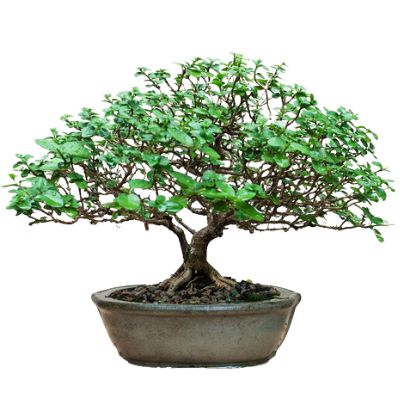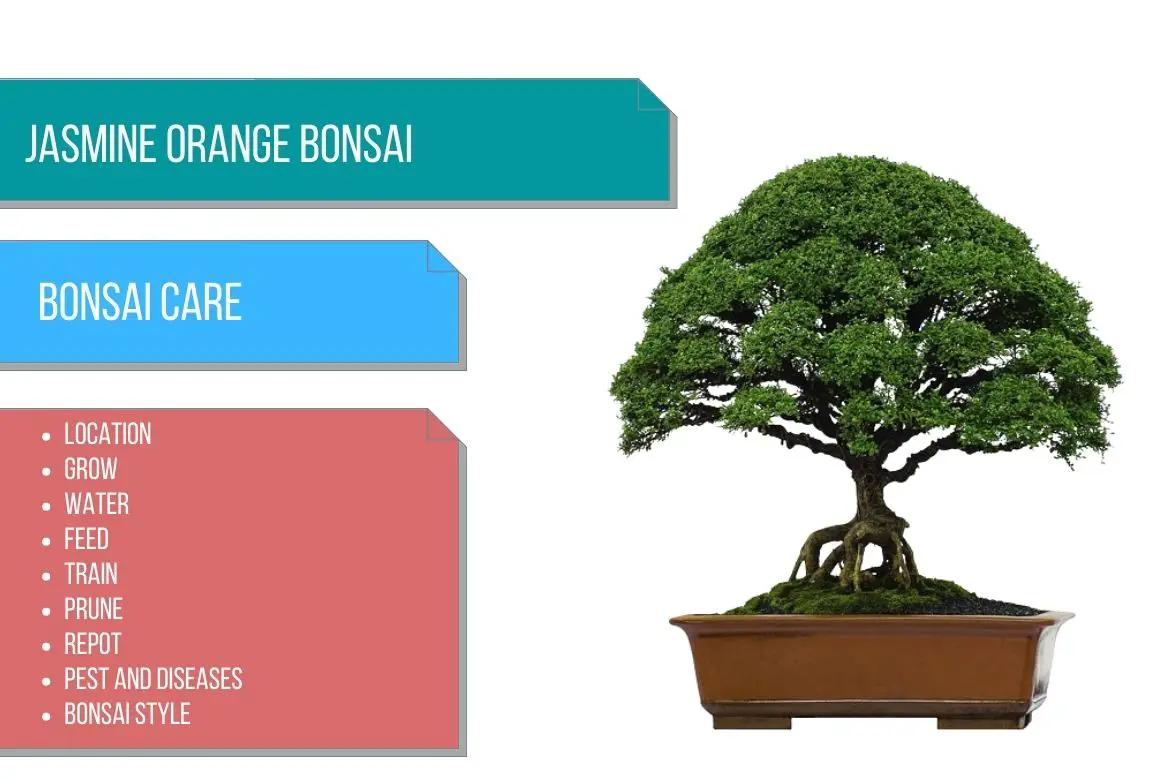
Jasmine Orange
(Murraya paniculata)
Country of Origin : Southern China and India
Bonsai Styles : Informal upright, slanting, semi-cascade, cascade, twin trunk, clump, group
Zone : 9 – 11
Jasmine orange tree, known for its white flowers and orange fruits, is a tropical tree and is also known as ‘satinwood tree‘. It got its name from the sweet-smelling white flowers that bloom on young shoots. However, interestingly it is not related to either jasmine or citrus fruits.
Jasmine orange bonsai makes a gorgeous bonsai specimen because of its delicate compound leaves and bark. The flowers and the fruits also add an attractive twist to the bonsai tree.
When the bark is young, it is smooth pale grayish brown. And when the trunk ages, it develops fine vertical ridges and its grey color deepens.
The pinnate, glossy, dark green compound leaves are held on stiff stems.
When it’s warm enough, the plants bear clusters of bell-shaped fragrant white flowers all year round, after which red berries are produced on the tree.
Jasmine orange bonsai tree that is well-taken care of will reward you almost continually with flowers and fruits.

Important Note : Growing it successfully as an indoor bonsai is challenging, making it not suitable as a ‘starter’ bonsai plant. Any bonsai style except windswept is suitable for Murraya paniculata bonsai.
Best location to keep Jasmine Orange Bonsai
The jasmine orange is a tropical plant that thrives in hot, steamy areas with ample rainfall.
The ideal temperature to grow jasmine orange bonsai tree is above 65°F (18°C).
It can survive a temperature as low as 54°F (12°C), but for a very brief period.
The plant will benefit from being exposed to some sunlight, once acclimatized by increasing daily exposure.
The bonsai container must be kept in a bright, warm, humid, and drought-free environment. Also, provide shade from the hot summer sun. In the middle of summer, Murraya can be left outside at night.
Providing such kinds of conditions inside the house all year round is difficult and hence growing a jasmine orange bonsai tree as an indoor bonsai is challenging.
In temperate climates, it is necessary to keep the tree indoors from early fall until the last frost in spring.
A good location for keeping this bonsai tree in the house can be a sunny windowsill of a heated bathroom or kitchen. However, make sure that this window is not opened in winter.
Refer sunlight requirements for indoor plants for more indoor gardening ideas. Also, refer to do bonsai trees need sunlight for more indoor and outdoor bonsai location ideas.
Propagation of Jasmine Orange
Jasmine orange tree can be propagated by sowing seeds in fall.
They can also be propagated by softwood cutting in summer or spring.
If the fruit is sown right from the tree and kept at 86°F (30°C), it should germinate
Watering Jasmine Orange Bonsai
When active growth is occurring (in summers), water well. Reduce water slightly when growth slows in the winter. In its natural setting, the tree has a very short or nonexistent dormant season.
Keep the soil moist at all times. Jasmine orange bonsai trees require moisture all year round.
Spray mist on the foliage regularly to mimic a humid environment.
You can also use the immersion technique once a week to water the bonsai tree.
Read watering bonsai tree for more details.

Due to its tendency to grow all year round, this species needs a relatively constant supply of water and nutrients. Your local conditions will affect how you water and feed this species.
As an example, if you live in a northern latitude, low light levels in winter will almost completely halt the growth of plant life, even though your indoor temperature may be near tropical. The plant will therefore need less water and feed as a result.
Furthermore, if you live further south, you will have higher levels of winter light, your trees will grow more, and you will therefore need more water and fertilizer.
Observe the tree and let it tell you what it needs.
Moisture will be retained in the soil for longer when growth slows. At this point, feed and water should be reduced.
As growth resumes, the soil will dry out faster, so more feed and water are needed.
Wiring Jasmine Orange Bonsai
Jasmine orange is grown extensively throughout Asia for the hardness of its wood, and woody branches are almost impossible to bend with wire, so any shaping must be done before the stems harden.
As a tree, jasmine orange is widely grown in Asia because of its hard wood.
Because of its hard woody branches, wiring and training the jasmine orange bonsai tree when the shoots are hard is almost impossible.
In case you are planning to wire the tree, do it before the branches become hard.
Branches that are young and semi-hard can be wired at any time of the year. However, do not leave the wires on the tree for more than 8 weeks.
Pruning Jasmine Orange Bonsai
When to prune Jasmine orange bonsai?
How to prune jasmine orange bonsai?
The plant can be heavily pruned to shape in the spring, and it can also be pruned in light amounts throughout the growing season.
Also, hard pruning of the branches can be done in winter. Make sure to seal the pruning wounds so that die-back doesn’t happen. In cases of die-back, include it in the bonsai style by creating intriguing hollows.
Tone down the color of the exposed wood with a lime-sulfur solution containing a bit of Indian ink.
The bark separates easily from heartwood, so use a sharp tool and cut carefully while pruning.
Make sure not to prune out the flowering shoots.
Pinching Jasmine Orange Bonsai
When you have established the silhouette of the foliage clouds, pinch out the growing tips of all the extending branches.
When new shoots have produced five or six leaves, prune them back to two leaves.
Take care to remove dead twigs.
Repotting Jasmine Orange Bonsai
When to repot Jasmine Orange bonsai?
Jasmine orange bonsai tree can be repotted in spring.
Repotting can be done every 2 to 3 years.
You should keep the bonsai pot warm after repotting so that the roots can regenerate.
You can use a basic free-draining bonsai soil mix as a potting soil.
OR
You can also use a soil mix consisting of 30% grit and 70% organic matter.
OR
You can also use a mix of peat (or compost), sharp sand and loam in the ratio of 1:1:2.
Must Read: Bonsai Soil Recipes
Must read : Choosing the right bonsai container
Feeding Jasmine Orange Bonsai
From spring to late summer, apply a general fertilizer once every 2 weeks.
To promote flowering next year, apply a feed high in potassium and phosphates in the fall.
Stop feeding the tree during the winter months. (Or you can feed every 4-6 weeks. Depends on your experience with the tree.)
Read more about bonsai fertilizer and its application.
Diseases and pest of Jasmine Orange Bonsai
Be on the lookout for whiteflies and aphids, which often leave sticky honeydew on leaves, on which sooty mold can form.
Handpicking can be used to remove aphids. If any problem persists, you should spray the leaves to clean them and use a systemic insecticide.
The presence of red spider mites will be a problem if the plants are kept in an insufficiently humid environment.
Also, mildew will occur on plants that do not have good air circulation (especially in indoor conditions). Maintain good air ventilation.
Jasmine Orange bonsai care
Unless handled carefully, the thick bark can easily separate from the heartwood. Therefore, do not apply excessive pressure when wiring. Also, do not use blunt pruning tools.
Both above and below ground, tropical plants are used to humid conditions. If you spray your leaves a few times a day, they will look brighter and healthier, and you should never let the roots dry out.
Like stated before, use the immersion technique to water the bonsai once a week if possible. This will make sure that there are no air pockets or dry inner core in the soil (which is sometimes not taken care of in overhead watering).
The idea that tropical trees need protection against the sun might seem strange, however, remember they are forest trees with roots constantly shaded by the canopy. Hence, in hot weather, provide some shade to the bonsai tree so that the roots are not overheated.
What to look for when buying Jasmine Orange Bonsai
Before buying, make sure the tree is held firmly by the soil in its pot.
It is common to cut a field-grown trunk to about a foot high and then grow them to produce the new shoots as branches to make Murraya paniculata bonsai.
However, this cutting process if not done correctly can result in bonsai tree having unsightly scars. Hence, avoid such specimens.
Also, heavy pruning can result in hollow trunks. As long as the decay is stopped before it reaches the roots, these are harmless to the tree and can even add to the beauty of the tree.


